Hair Loss Overview

Hair loss is extremely common, affecting about 50 million men and 30 million women in the U.S. About 50% of men will have some hair loss by the time they turn 50. Hair loss is not life-threatening, though it can have devastating psychological effects, particularly in women.
What Are Causes of Hair Loss?
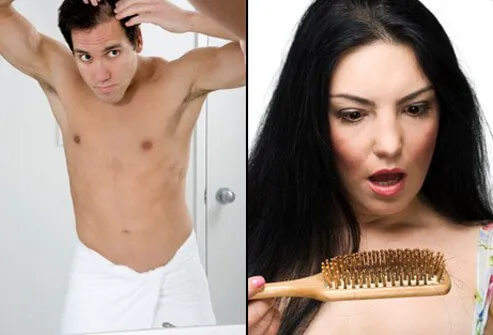
Hair loss is often caused by genetics, that is, it runs in families. In general, it is not a symptom of disease, however, thyroid disease, anemia, ringworm of the scalp, and anorexia can cause hair loss. In addition, some medications such as cancer chemotherapy may cause temporary hair loss. Hair growth usually returns to normal when the medications are stopped. In some cases, hormones changes after giving birth or during menopause can cause thinning hair.
Types of Hair Loss
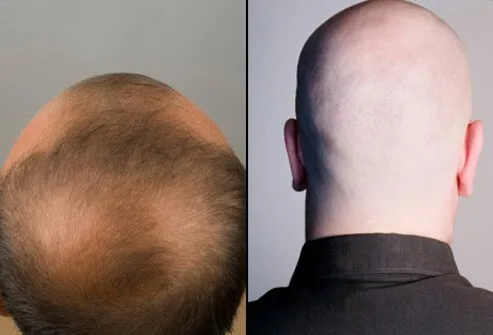
There are several types of hair loss, often classified by whether the loss is localized, or if it affects large areas, or if the hair loss is patchy or affects the entire scalp. Some of the more common hair loss causes are discussed on the following slides.
Alopecia Areata
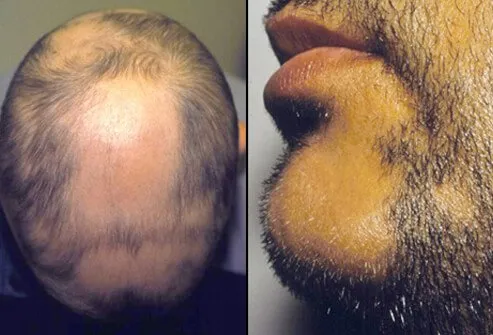
Alopecia areata (AA) is a common form of hair loss. It is believed to be an autoimmune condition where circular bald patches appear on the scalp and other hair-bearing areas. The hair loss may occur spontaneously, and the hair may regrow if the inflammation subsides. If the alopecia covers the entire scalp it is called alopecia totalis. If it spreads to the rest of the body including eyebrows, lashes, beard, and pubic hair it is called alopecia universalis. In men, if the alopecia appears only in the area of the beard it is called alopecia barbae.
Alopecia Areata (Continued)
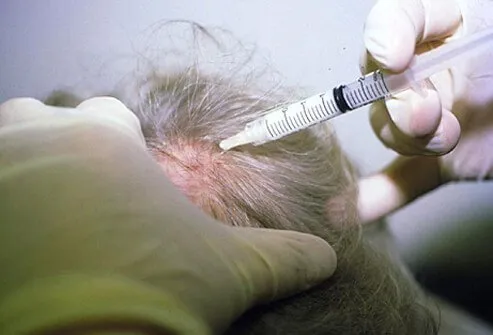
Alopecia areata is often mistakenly attributed to stress, though there is no evidence that shows this to be the case.
Traction Alopecia
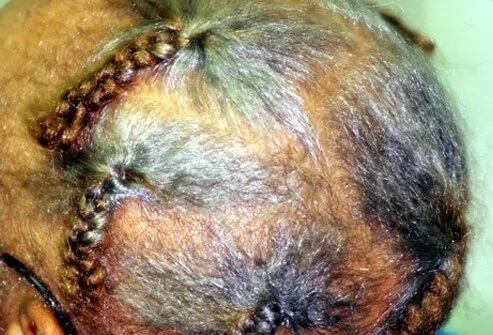
Traction alopecia is caused over time by constant pulling on hair roots. Hairstyles that cause tension on the hair follicles such as tight braids, or "corn rows," often cause this condition. It may also be caused by chemical straightening or weaving. The sooner this condition is diagnosed the easier it is to treat, and if left untreated over a long period of time, the hair loss may become permanent. Wearing hair in styles that are looser and do not pull on the roots is often the best way to prevent this type of hair loss.
Trichotillomania

A medical disorder that causes people to pull out their own hair is called trichotillomania. Often a person feels compelled to pull out hairs on their scalp, eyelashes, eyebrows, or other hairs on the body. Cognitive behavioral therapy and medications can help treat the condition.
Tinea Capitis (Fungal Infection)

Tinea capitis, or ringworm of the scalp, is a fungal infection that tends to attack hair shafts and follicles leading to hair loss. It appears as bald spots with black dots where the hair has broken off. It most commonly affects children, but can affect adults as well. Treatment usually includes antifungal compounds.
Telogen Effluvium
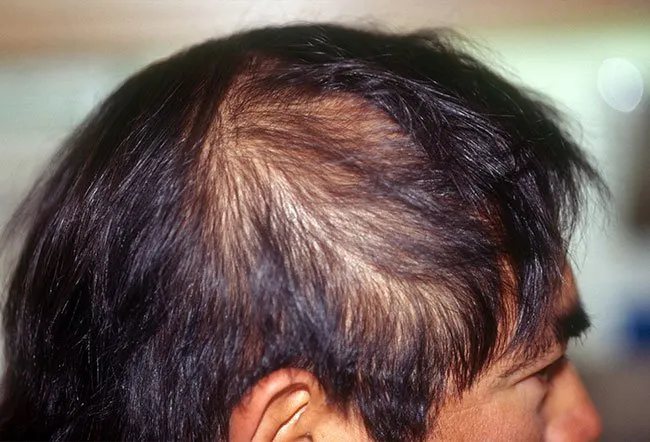
Telogen effluvium (TE) is a thinning of the hair on the scalp, not necessarily evenly. Hair growth involves several phases. Hair grows for a few years, rests (the telogen phase), sheds, and then regrows. When hair roots prematurely reach the resting phase, this is called telogen effluvium.
Telogen Effluvium (Continued)

Telogen effluvium is often caused by a "shock to the system," with the hair loss occurring weeks to months after the initial shock. Some causes of TE include:
- high fever
- childbirth
- severe infection
- chronic or severe illness
- severe psychological stress
- major surgery
- over or underactive thyroid
- crash diets
- medications, such as retinoids, beta blockers, calcium channel blockers, antidepressants, and nonsteroidal anti-inflammatories (NSAIDs).
Because the stage following the resting (telogen) phase is regrowth, there is no treatment needed. Hair will usually resume normal growth. It is important to first determine that there is no other underlying medical condition that is causing the hair loss.
Androgenetic Alopecia ("Male-Pattern Baldness," "Female-Pattern Baldness")
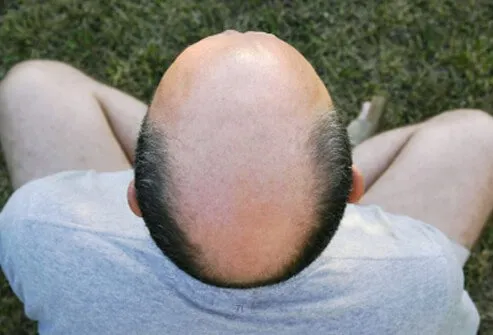
Androgenetic alopecia, also sometimes referred to as "male pattern baldness," accounts for the majority of hair loss in men, but it can also affect women. It is usually caused by a combination of hormones and genetics.
Male-Pattern Baldness

Some men may start to notice thinning hair as early as their 20s, and by age 50, 50% of men see some hair loss. Hair is usually lost in a pattern, starting at the temples, revealing the classic "M" shaped hairline seen as men age.
Myths About Male-Pattern Baldness
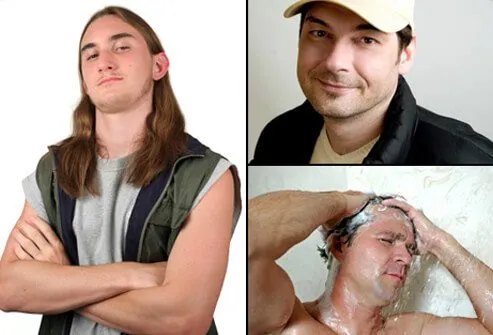
There are many myths about male-pattern baldness.
- MYTH: Baldness is inherited through the mother's side of the family. If your maternal grandfather was bald, you will be too.
- FACT: Genes for baldness can come from either parent.
- MYTH: Wearing hats strains hair follicles and causes hair loss.
- FACT: Unless your hat is so tight it cuts off circulation to hair follicles, it will not cause hair loss.
- MYTH: Using a blow dryer causes hair loss.
- FACT: Use of a blow dryer does not cause hair to fall out. However, frequent over-use of a hot dryer can cause hair to become brittle, damaged, and break, which may cause hair to appear thinner.
- MYTH: Washing hair too frequently or using certain styling products can cause hair to fall out.
- FACT: Shampoo and hair care products do not cause hair loss.
- MYTH: Massaging the scalp will help hair regrow by stimulating circulation around the follicles.
- FACT: It may make you feel good, but no studies have shown scalp massage helps regrow hair.
Female-Pattern Baldness
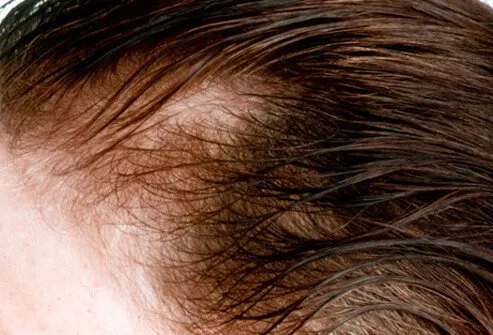
It's not just men who lose their hair. While men tend to start losing hair on their forehead hairline, women tend to notice hair loss appearing on the top and crown of the scalp. As in men, it may be related to genetics (family history), and it is more commonly seen after menopause. Unlike men, the hair loss does not tend to be total and the front hairline is not usually affected any more than it is in women without hair loss.
Myths About Female-Pattern Baldness
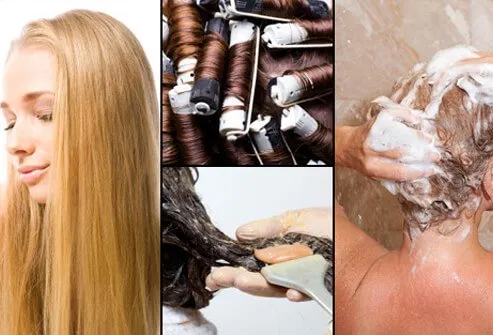
There are myths about female-pattern baldness just as there are with male-pattern baldness.
- Long hair does not strain the roots, causing hair to fall out.
- Shampooing, hair coloring, and other chemical processes usually do not cause hair loss.
- Brushing hair too much does not cause hair loss – hair that comes out from brushing or combing was ready to fall out anyway.
- While some hairstyles that pull hair tightly such as braids ("corn rows") or tight ponytails can cause traction alopecia, a type of hair loss, styling hair in general will not cause hair to fall out.
- Use of hair dryers or curling and flat irons does not cause hair to fall out. The heat from these appliances may damage hair, causing it to become brittle and break, giving the appearance of thinner hair, but they do not cause hair to fall out.
Hair Loss Treatment

First, it is important to determine that hair loss is not caused by an underlying medical condition. If that is the case, the medical condition needs to be addressed.
If there is no medical problem causing the hair loss, treatment options include medications, surgery, grooming techniques, wigs, and hairpieces.
Medications for Hair Loss

There is no shampoo, conditioner, or other product that will help hair to grow. There are, however, products that can slow down hair loss, including:
- Minoxidil (Rogaine)
- Finasteride (Propecia)
Minoxidil (Rogaine)

Minoxidil (Rogaine) is a topical medication available over-the-counter (OTC), without a prescription. In men, it is used to treat male-pattern baldness. In women it is used to treat thinning hair. It is applied directly to the scalp twice-daily, and there are few side effects. Once treatment with minoxidil is started, it must be continued. Once it's stopped the hair will start to fall out again.
Finasteride (Propecia)

Finasteride (Propecia) is a prescription medication that is taken orally. It can help grow and thicken hair, but it is mainly used to retain hair that is still on the scalp so it works best for men who have more hair already. A side effect of Propecia is impotence, which goes away when the drug is stopped. This drug is not considered safe for women of childbearing age, though it is probably safe for postmenopausal women.
Laser Treatments for Hair Loss

Low-dose laser therapy is being used under several names as a treatment for genetic baldness. This therapy is also called red light therapy, cold laser, soft laser, biostimulation, and photobiomodulation. Laser therapy may be used instead of, or in addition to, surgical options. Options include:
- Hoods worn inside a salon
- Caps and combs used at home
- Hand-held laser devices
Surgery for Hair Loss

Permanent hair loss can be treated with surgery. There are three common types of hair replacement surgery:
- Hair transplants – also called hair grafting - hair is taken from the back of the head and replaced in the front
- Scalp reduction – bald areas are surgically removed and the hair-bearing areas of the scalp are stitched together
- Scalp expansion – devices are inserted under the scalp to stretch the skin. This may be used before scalp reduction to help make the scalp laxer, or on hair-bearing areas, which can reduce balding.
These procedures are best for men with male-pattern baldness, and some women with female-pattern baldness. It is not recommended for people who do not have sufficient hair in "donor" sites (the parts of their scalp where hair will be taken), and people who tend to form keloid scars.
Grooming Techniques, Wigs, Hairpieces, etc.

When hair loss is mild, styling hair to cover areas of thinning hair can often be effective. Many volumizing shampoos and conditioners can help give volume to hair and make it appear thicker. Consult your hair stylist about the best haircut to help your hair appear thicker.
Other options include wigs or hairpieces for more severe or widespread hair loss. Hair weaves can also be attached to existing hair to fill in thinning areas.
Hair Loss: Alopecia, Thinning Hair in Men and Women
This tool does not provide medical advice. See additional information: 
© 1996-2024 WebMD, LLC. All rights reserved.
